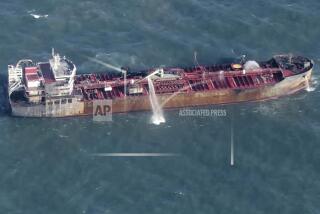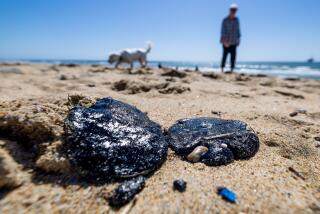Mooring Firm, Pilot Blamed in Tanker Spill : Pollution: The Coast Guard says water depth information at the site off Orange County was inadequate. The ship hit its own anchor, losing 397,000 gallons of oil.
- Share via
WASHINGTON — The U.S. Coast Guard, in a report issued Wednesday, officially blamed the February oil spill off Orange County on the oil company that operated the mooring where a tanker ran over its anchor and on the pilot who was guiding the ship.
The accident occurred because Golden West Refining Co. failed to regularly survey the depth of the water surrounding its mooring 1.3 miles southwest of Huntington Beach, where the American Trader spilled 397,000 gallons of crude oil into the ocean, the report said.
A second cause, the Coast Guard concluded, was the failure of the mooring master, Capt. John Keon, 41, of San Jacinto “to be fully cognizant of the accurate sea berth water depth information.” A mooring master is an independent local captain who is hired by vessel operators to guide large ships to offshore moorings.
However, the Coast Guard concluded that neither Santa Fe Springs-based Golden West nor Keon violated any federal laws “for which the Coast Guard has enforcement responsibility,” and the agency said it would take no action against Keon or other Coast Guard-licensed personnel involved in the spill.
Keon was not available for comment and Roger Kemple, senior vice president of Golden West in Santa Fe Springs, said Wednesday that the company had not received a copy of the report and would have no comment.
The crew and captain of the American Trader, A. R. LaWare of Texas, were not at fault, the Coast Guard said.
The Coast Guard noted, however, that the American Trader’s owner, the American Trading and Transport Co., may have violated the federal Water Pollution Control Act by dumping crude oil into the ocean.
Experts said the Coast Guard report could be used as evidence in any civil suits stemming from the oil spill.
But William E. O’Neil, chairman of the American Bar Assn.’s standing committee on admiralty and maritime law, said reports from investigations by the Coast Guard are not legally binding like court findings of blame.
“This is an administrative body coming up with findings of fact,” said O’Neil, contacted by telephone at his New Orleans office. “Such findings may be introduced as evidence (in civil suits), but the findings do not determine the rights of the victims.” Only a court, he added, can rule on whether a person or company is liable for damage.
In response to the accident, the Coast Guard said it is assembling a task force to review port safety issues, including bottom-clearance requirements for oil tankers. The Coast Guard also will look at licensing and training requirements for mooring masters.
The spill occurred as the American Trader, laden with 568,000 barrels of Alaskan crude, approached a cluster of seven Golden West moorings on the afternoon of Feb. 7. The tanker, under lease to British Petroleum Oil Shipping Co. USA, was to discharge 300,000 barrels of its cargo into a pipeline to a Golden West marine terminal in Huntington Beach. The oil ultimately was to have gone to the company’s refinery in Santa Fe Springs.
As the tanker drew close to the mooring, it dropped two anchors. While the evidence is not conclusive, the Coast Guard said it believes the ship ran aground on its left-side anchor, which ruptured the single-hulled ship and sent oil spilling into the ocean.
Keon, hired by British Petroleum to guide the ship to the mooring, told the Coast Guard that he always had believed that the water surrounding the approach to the Golden West mooring was 56 feet deep.
But the Coast Guard said, “The only information he had was verbal.” Keon was unaware, the agency said, of two independent depth surveys of the area surrounding the mooring that had been conducted in 1981 and 1983. Golden West, which acquired its refinery, marine terminal and offshore mooring from Gulf Oil in 1983, had not done any additional depth surveys in the intervening seven years.
According to the Coast Guard, the 1981 survey showed that the shallowest water in the vicinity of the mooring measured 45.5 feet, while the 1983 survey put the shallowest water at 45.9 feet. A survey conducted after the accident found the shallowest part of the mooring area measured 47 feet deep.
At the time of the accident, the American Trader was drawing 43 feet of water in swells that occasionally measured 4.5 feet, the Coast Guard concluded.
Instead of the 13 feet of clearance that Keon believed was available, actual clearance from the bottom could have been as little as four feet, or even less with the swells. Under those circumstances, it is not surprising that the ship ran aground on one of its anchors, the Coast Guard said.
The report states: “The mooring master has a responsibility to his employer for being fully cognizant of accurate sea berth water depth information and appropriate terminal operating parameters.”
In addition, the Coast Guard said, “The terminal operator has a responsibility to periodically conduct water depth surveys in the immediate area of the terminal; to fully evaluate this information and designate appropriate terminal operating parameters; and to ensure that both . . . are made readily available to terminal users.”
The Coast Guard’s final conclusions were significantly toughened after the report was shipped to Washington from the Coast Guard’s marine safety office in Long Beach.
For example, the original investigators did not mention Golden West or Keon by name. Their original finding read in part, “The proximate cause of this casualty was inadequate water depth . . . the lack of knowledge regarding it was a key factor in this casualty.”
The blame was fixed on Golden West and Keon at Coast Guard headquarters bH. Whitten, acting deputy chief in the office of marine safety, security and environmental protection, whose findings represent the Coast Guard’s official conclusions.
The Coast Guard on April 26 announced unprecedented restrictions on tanker traffic at the Golden West mooring, requiring at least six feet of clearance between the bottom of a tanker and any known obstruction on the ocean floor, including an anchor. The new rules also require monthly depth readings at the mooring and depth soundings before each tanker arrival.
Times staff writer Bill Billiter contributed to this article.
More to Read
Sign up for Essential California
The most important California stories and recommendations in your inbox every morning.
You may occasionally receive promotional content from the Los Angeles Times.













